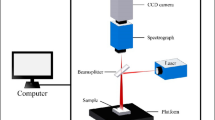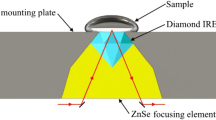Abstract
Aspergillus colonization on peanuts is a growing concern, as it results in reduced crop yields or livestock productivity due to consumption of contaminated feed, and most importantly, they are famous as causative agents of opportunistic infestation in man. In order to defeat and evaluate peanuts suffering from Aspergillus infection, it is essential to establish proper technique and track the quality of peanuts at both farm and market levels. This study focuses on usage of Fourier transform mid-infrared spectroscopy (FTIR) with a non-invasive reflectance apparatus, photoacoustic spectroscopy (PAS) to identify and separate infected peanuts based on spectral characteristics of infrared radiation on peanuts. Classes were defined as “clean” representing no-aflatoxin/no-mold in peanuts, “moldy” representing peanuts with non-aflatoxigenic Aspergillus strains, and lastly, “toxic” representing peanuts infected with aflatoxigenic strains of Aspergillus spp. Classes were analyzed using discriminant analysis algorithm, and distance values were calculated in Mahalanobis distance units. The spectral ranges between 3600 and 2750, 1800 and 1480, and 1200 and 900 cm−1 were assigned as the key bands, and corresponding vibration modes and intensities were labeled. All healthy, clean peanuts (15 healthy/69 total peanut pods) were successfully separated from moldy ones. Separation was further detailed to distinguish peanuts infected with aflatoxin producing strains of Aspergillus flavus and Aspergillus parasiticus, and as a result, 87 % of samples were separated correctly as only moldy or toxic streams. Performance test was conducted with 36 different samples including toxic, moldy, and clean samples; 80.6 % correct classification was achieved.







Similar content being viewed by others
References
Beekes M, Lasch P, Naumann D (2007) Analytical applications of Fourier transform-infrared (FT-IR) spectroscopy in microbiology and prion research. Vet Microbiol 123:305–319. doi:10.1016/j.vetmic.2007.04.010
Bennett JW (2010) An overview of the genus Aspergillus. In: Machida M, Wymondham KG (eds) Aspergillus: molecular biology and genomics. Caister Academic Press, Norfolk, UK, pp 1–17
Bothast RJ (1978) Fungal deterioration and related phenomena in cereals, legumes and oilseeds. In: Hultin HO, Milner M (eds) Post-harvest biology and biotechnology. Food and Nutrition Press, Inc., Westport, pp 210–243
Desjardins AE, Manandhar G, Plattner RD, Maragos CM, Shrestha K, McCormick SP (2000) Occurrence of Fusarium species and mycotoxins in Nepalese maize and wheat and the effect of traditional processing methods on mycotoxin levels. J Agric Food Chem 48:1377–1383
Diener UL, Cole RJ, Sanders TH, Payne GA, Lee LS, Klich MA (1987) Epidemiology of aflatoxin formation by Aspergillus-flavus. Annu Rev Phytopathol 25:249–270. doi:10.1146/annurev.py.25.090187.001341
Fandohan P, Zoumenou D, Hounhouigan DJ, Marasas WFO, Wingfield MJ, Hell K (2005) Fate of aflatoxins and fumonisins during the processing of maize into food products in Benin International. J Food Microbiol 98:249–259. doi:10.1016/j.foodchem.2004.07.007
FAO (2001) FAO/IAEA Manual on the application of the HACCP system in mycotoxin prevention and control, FAO Food and Nutrition Paper 73, FA, Rome, Italy
Farsaie A, McClure WF, Monroe RJ (1977) Development of indices for sorting Iranian pistachio nuts according to fluorescence. J Food Sci 43:1550–1552
Fischer G, Braun S, Thissen R, Dott W (2006) FT-IR spectroscopy as a tool for rapid identification and intra-species characterization of airborne filamentous fungi. J Microbiol Methods 64:63–77
Gordon SH, Schudy RB, Wheeler BC, Wicklow DT, Greene RV (1997) Identification of Fourier transform infrared photoacoustic spectral features for detection of Aspergillus flavus infection in corn. Int J Food Microbiol 35:179–186
Greene RV, Gordon SH, Jackson MA, Bennett GA, McClelland JF, Jones RW (1992) Detection of fungal contamination in corn—potential of FTIR-PAS and FTIR-DRS. J Agric Food Chem 40:1144–1149
Guillen MD, Cabo N (1997) Infrared spectroscopy in the study of edible oils and fats. J Sci Food Agric 75:1–11
Hirano S, Okawara N, Narazaki S (1998) Near infrared detection of internally moldy nuts. Biosci, Biotechnol, Biochem 62:102–107
Horn BW (1997) Aspergillus caelatus, a new species in section. Flavi Mycotaxon 61:185–191
Horn BW (2005) Colonization of wounded peanut seeds by soil fungi: selectivity for species from Aspergillus section. Flavi Mycologia 97:202–217. doi:10.3852/mycologia.97.1.202
Horn BW, Greene RL, Sobolev VS, Dorner JW, Powell JH, Layton RC (1996) Association of morphology and mycotoxin production with vegetative compatibility groups in Aspergillus flavus, A.parasiticus, and A.tamarii. Mycologia 88:574–587. doi:10.2307/3761151
Irudayaraj J, Sivakesava S, Kamath S, Yang H (2001) Monitoring chemical changes in some foods using Fourier transform photoacoustic spectroscopy. J Food Sci 66:1416–1421
Irudayaraj J, Yang H, Sakhamuri S (2002) Differentiation and detection of microorganisms using Fourier transform infrared photoacoustic spectroscopy. J Mol Struct 606:181–188. doi:10.1016/s0022-2860(01)00869-9
Ismail AA, Vandevoort FR, Emo G, Sedman J (1993) Rapid quantitative-determination of free fatty-acids in fats and oils by Fourier-transform infrared-spectroscopy. J Am Oil Chem Soc 70:335–341. doi:10.1007/bf02552703
Jouany JP (2007) Methods for preventing, decontaminating and minimizing the toxicity of mycotoxins in feeds. Anim Feed Sci Technol 137:342–362. doi:10.1016/j.anifeedsci. 2007.06-009
Kaaya AN, Kyamuhangire W (2006) The effect of storage time and agroecological zone on mould incidence and aflatoxin contamination of maize from traders in Uganda. Int J Food Microbiol 110:217–223. doi:10.1016/j.ijfoodmicro.2006.04.004
Kaya-Celiker H, Mallikarjunan PK, Schmale D, Christie ME (2014) Discrimination of moldy peanuts with reference to aflatoxin using FTIR-ATR system. Food Control 44:64–71. doi:10.1016/j.foodcont.2014.03.045
Kaya-Celiker H, Mallikarjunan PK, Kaaya A (2015) Mid-infrared spectroscopy for discrimination and classification of Aspergillus spp. contamination in peanuts. Food Control 52:103–111
Lamb MC, Sternitzke DA (2001) Cost of aflatoxin to the farmer, buying point, and sheller segments of the southeast United States peanut industry. Peanut Sci 28:59–63
Mariey L, Signolle JP, Amiel C, Travert J (2001) Discrimination, classification, identification of microorganisms using FTIR spectroscopy and chemometrics. Vib Spectrosc 26(2):151–159. doi:10.1016/s0924-2031(01)00113-8
McClure WF, Farsaie A (1980) Dual-Wavelength Fiber Optic Photometer Measures Fluorescence of Aflatoxin Contaminated Pistachio Nuts Trans ASAE:204-207
Mellon JE, Dowd MK, Cotty PJ (2002) Time course study of substrate utilization by Aspergillus flavus in medium simulating corn (Zea mays) kernels. J Agric Food Chem 50:648–652. doi:10.1021/jf011048e
Murphy PA, Hendrich S, Landgren C, Bryant CM (2006) Food mycotoxins: an update. J Food Sci 71:R51–R65. doi:10.1111/j.1750-3841.2006.00052.x
Pasikatan MC, Dowell FE (2001) Sorting systems based on optical methods for detecting and removing seeds infested internally by insects or fungi: a review. Appl Spectrosc Rev 36(4):399–416
Paterson RRM (2006) Fungi and fungal toxins as weapons. Mycol Res 110:1003–1010. doi:10.1016/j.mycres.2006.04.004
Pearson TC, Wicklow DT, Maghirang EB, Xie F, Dowell FE (2001) Detecting aflatoxin in single corn kernels by transmittance and reflection spectroscopy. Trans ASAE 44:1247–1254
Pearson TC, Wicklow DT, Pasikatan MC (2004) Reduction of aflatoxin and fumonisin contamination in yellow corn by high-speed dual-wavelength sorting. Cereal Chem 81:490–498
Peterson SW (2008) Phylogenetic analysis of Aspergillus species using DNA sequences from four loci. Mycologia 100:205–226. doi:10.3852/mycologia.100.2.205
Pitt JI, Basilico JC, Abarca ML, Lopez C (2000) Mycotoxins and toxigenic fungi. Med Mycol 38:41–46
Sanders TH (2003) Peanuts. In: Caballero B (ed) Encyclopedia of food sciences and nutrition, 2nd edn. Academic, Oxford, pp pp 4420–pp 4427. doi:10.1016/B0-12-227055-X/00897-X
Thompson SE, Foster NS, Johnson TJ, Valentine NB, Amonette JE (2003) Identification of bacterial spores using statistical analysis of Fourier transform infrared photoacoustic spectroscopy data. Appl Spectrosc 57:893–899. doi:10.1366/000370203322258832
Tyson TW, Clark RL (1974) An investigation of the fluorescent properties of aflatoxin infected pecans. Trans ASAE 17:942–948
Williams JH, Phillips TD, Jolly PE, Stiles JK, Jolly CM, Aggarwal D (2004) Human aflatoxicosis in developing countries: a review of toxicology, exposure, potential health consequences, and interventions. Am J Clin Nutr 80(5):1106–1122
Acknowledgments
Authors wish to express their acknowledgements for funding provided by the Peanut CRSP program (a USAID-funded project) on aflatoxin management and mitigation (VT-134). Authors also would like to extend their gratitude to Dr. Maria Elisa Christie and Charity Mutegi for their participation in the project.
Conflict of Interest
P. Kumar Mallikarjunan is the Principal Investigator of the project funded by US Agency for International Development (USAID). Hande Kaya-Celiker received graduate student support to pursue her doctoral degree from the funds provided by USAID and Archileo Kaaya is the collaborator in the project funded by USAID.
Compliance with Ethics Requirements
This article does not contain any studies with human or animal subjects.
Author information
Authors and Affiliations
Corresponding author
Rights and permissions
About this article
Cite this article
Kaya-Celiker, H., Mallikarjunan, P.K. & Kaaya, A. Characterization of Invasion of Genus Aspergillus on Peanut Seeds Using FTIR-PAS. Food Anal. Methods 9, 105–113 (2016). https://doi.org/10.1007/s12161-015-0159-x
Received:
Accepted:
Published:
Issue Date:
DOI: https://doi.org/10.1007/s12161-015-0159-x




